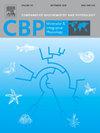Hibernation enhances contractile responses of basilar artery in ground squirrels: The role of Rho-kinase and NO
IF 2.1
3区 生物学
Q4 BIOCHEMISTRY & MOLECULAR BIOLOGY
Comparative Biochemistry and Physiology A-Molecular & Integrative Physiology
Pub Date : 2024-12-22
DOI:10.1016/j.cbpa.2024.111796
引用次数: 0
Abstract
Hibernation is accompanied by dramatic decrease of blood flow in many organs due to the increase of their vascular resistances. We compared the responses of mesenteric, renal, and cerebral proximal resistance arteries in summer active (SA) and winter hibernating (WH) ground squirrels and studied the signaling pathways of Rho-kinase and NO. Wire myography and Western blotting were used to assess the arterial responses and protein abundances. Basal tone and contractile responses did not differ between SA and WH squirrels in mesenteric and renal arteries, but were greatly increased in basilar arteries of WH compared to SA. Rho-kinase inhibitor abolished the differences in basilar artery basal tone and contractile responses between WH and SA squirrels, while the content of Rho-kinase II protein in the cerebral arteries did not differ between the groups. NO-synthase inhibitor increased basal tone level and basilar artery contractile responses only in SA but not in WH animals, so that the intergroup differences disappeared. The responses of basilar artery to the NO-donor and eNOS protein content did not differ between the two groups, while nNOS protein content was reduced in WH compared to SA. Therefore, the increase of basilar artery basal tone and contractile responses in hibernating animals is due to the increase of procontractile influence of Rho-kinase and the decrease of anticontractile influence of NO. Localization of high resistance in the hibernating brain at the level of proximal resistance arteries may be important for rapid restoration of cerebral blood flow upon arousal from hibernation.

冬眠增强地鼠基底动脉的收缩反应:rhok和NO的作用。
冬眠时,由于血管阻力增加,许多器官的血流量急剧减少。我们比较了夏季活动(SA)和冬季冬眠(WH)地松鼠肠系膜、肾脏和大脑近端抵抗动脉的反应,并研究了rho激酶和NO的信号通路。采用钢丝肌图和Western blotting评估动脉反应和蛋白丰度。小黄鼠和白脑鼠在肠系膜动脉和肾动脉的基底张力和收缩反应无显著差异,但白脑鼠基底动脉的收缩反应明显高于白脑鼠。rho激酶抑制剂消除了WH和SA松鼠基底动脉基底张力和收缩反应的差异,而脑动脉rho激酶II蛋白含量在组间无差异。no合酶抑制剂仅在SA动物中增加基底张力水平和基底动脉收缩反应,而在WH动物中没有,因此组间差异消失。基底动脉对no供体的反应和eNOS蛋白含量在两组间无差异,而WH中nNOS蛋白含量较SA降低。因此,冬眠动物基底动脉基底张力和收缩反应的增加是由于rho激酶的促收缩作用增强而NO的抗收缩作用减弱。在冬眠的大脑中,近端阻力动脉水平的高阻力定位可能对从冬眠唤醒后脑血流的快速恢复很重要。
本文章由计算机程序翻译,如有差异,请以英文原文为准。
求助全文
约1分钟内获得全文
求助全文
来源期刊
CiteScore
5.00
自引率
4.30%
发文量
155
审稿时长
3 months
期刊介绍:
Part A: Molecular & Integrative Physiology of Comparative Biochemistry and Physiology. This journal covers molecular, cellular, integrative, and ecological physiology. Topics include bioenergetics, circulation, development, excretion, ion regulation, endocrinology, neurobiology, nutrition, respiration, and thermal biology. Study on regulatory mechanisms at any level of organization such as signal transduction and cellular interaction and control of behavior are also published.

 求助内容:
求助内容: 应助结果提醒方式:
应助结果提醒方式:


